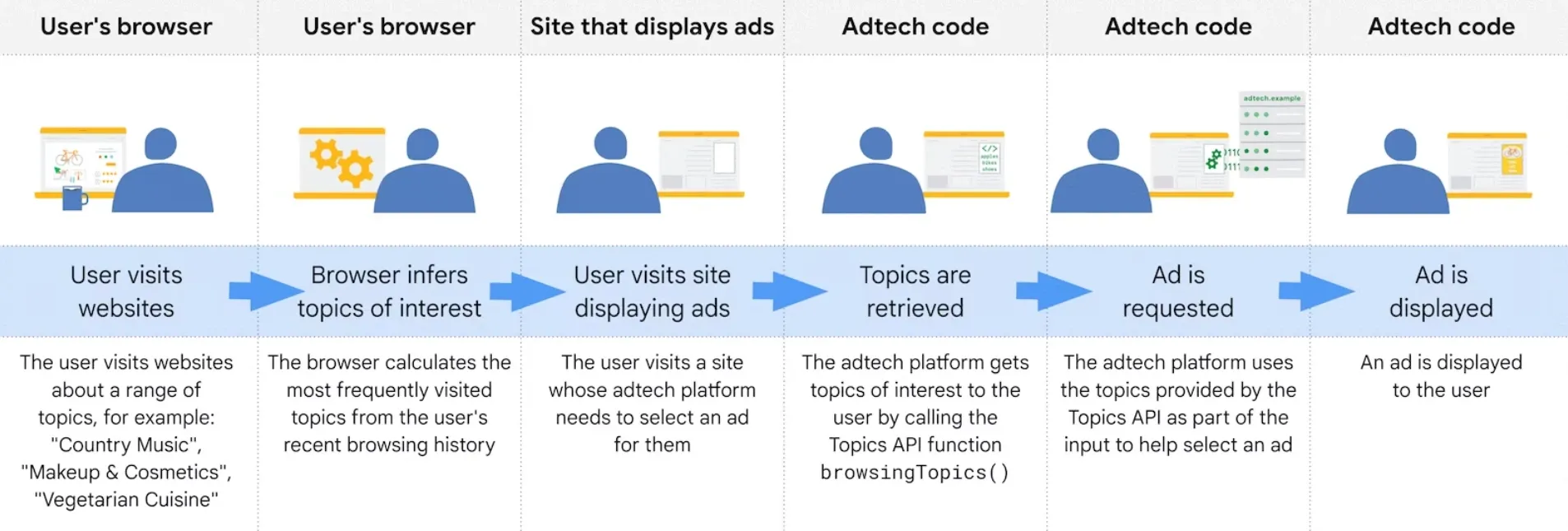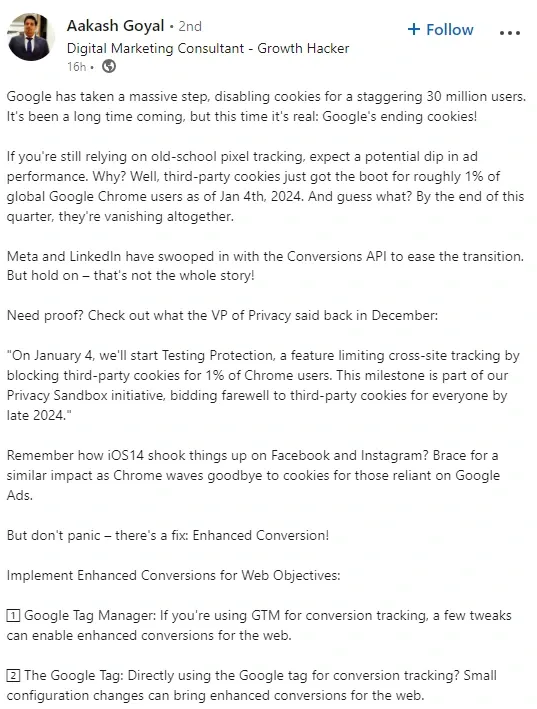On January 4th, a new chapter in digital browsing began as Google started phasing out third-party cookies for 30 million users, a significant first step in a broader plan to eliminate them in Chrome by the third quarter of 2024.
As users, we’ve enjoyed the benefits of personalized web experiences, appreciating the tailored content and relevant suggestions that make our online journey more enjoyable and efficient. Among these, third-party cookies have been pivotal, yet they come with privacy trade-offs that can no longer be overlooked.
In this blog, we’ll delve into what Google Tracking Protection is, why it’s important, and how it marks a new chapter in the balancing act between digital convenience and user privacy. Understanding this shift is crucial, not just for tech enthusiasts but for anyone who browses the internet and cares about how their digital footprint is managed.
The Role and Impact of Third-Party Cookies
Third-party cookies have long been the backbone of online tracking, silently working behind the scenes every time we browse the web. But what exactly are they?
Upon visiting a website, cookies are deposited onto your browser. The cookies generated by the website you are currently browsing are referred to as “first-party cookies” Nevertheless, numerous websites incorporate components from external sources, such as advertisements or social network widgets. These elements also can store cookies on your browser, commonly referred to as “third-party cookies”.
They are mainly used for cross-site tracking and online advertising. Moreover, these cookies also track our online movements across different websites, compiling a detailed profile of our interests, preferences, and even locations. Now this data has become a goldmine for advertisers seeking to deliver more personalized digital experiences. But as you might guess, it raises significant privacy concerns.
With an explosion in data gathering and processing, new privacy regulations were necessary and hence the General Data Protection Regulation (GDPR) was introduced in 2018. Its primary goals were to strengthen the protection of personal data, unify data privacy laws across the European Union, and give individuals more control over their personal information.
Soon the importance and timeliness of GDPR were made more apparent by the Facebook and Equifax data breaches. These high-profile incidents highlighted the vulnerabilities in data security and the potential consequences of mishandling personal data. They brought widespread public attention to the issues of privacy and data protection, emphasizing the need for stringent regulations.
It’s this growing unease about privacy that has led to a reevaluation of third-party cookies’ role in our digital lives, setting the stage for new solutions like Google Tracking Protection.
Google’s Pivot to Privacy: Introducing Tracking Protection
Google’s response to the rising privacy concerns is a significant pivot towards enhanced user privacy, epitomized by the introduction of Tracking Protection. This feature is a key component of Google’s ambitious Privacy Sandbox initiative. The initiative aims to redefine the balance between delivering personalized web experiences and safeguarding user privacy. But how does Tracking Protection fit into this?
Tracking Protection is essentially Google’s way of phasing out the traditional third-party cookie model. Instead of allowing various websites to place their cookies on your browser, thereby tracking your activities across the web, Tracking Protection limits this capability. It functions by blocking third-party cookies by default, effectively putting a barrier to the kind of widespread tracking we’ve become accustomed to.
The beauty of Tracking Protection lies in its approach. While it restricts third-party cookies, it doesn’t completely eradicate the concept of understanding user preferences for a personalized online experience.
With Google’s Topics API, the browser keeps track of things that the user seems to be interested in based on how they browse. This information is saved locally on the device of the user. The Topics API can then let API callers, like ad tech platforms, see what topics a user is interested in without giving away any other details about what the user is browsing.
Here’s a simplified example that shows how the Topics API could help an ad tech platform choose the right ad.
simplified-example-about-how-the-topics-api-could-help-an-ad-tech-platform
Impact of Tracking Protection
With Tracking Protection, your online behavior is less transparent to countless advertisers and data brokers. This means a decrease in the strangely accurate targeted ads that are based on your browsing history, offering a sense of privacy that’s been gradually diminishing in the modern digital age. It also gives you more control over your data, aligning with the growing demand for transparency and consent in data collection.
On the flip side, the digital advertising landscape faces a seismic shift. Advertisers and marketers, long reliant on the detailed user profiles built from third-party cookies, will need to adapt to this new, more privacy-focused environment.
While Tracking Protection doesn’t eliminate the concept of targeted advertising, it forces a move towards less invasive methods, such as contextual advertising based on the content being viewed rather than the user’s browsing history.
Deirdre Bosa, TechCheck Anchor at CNBC accurately explains in this video what this means for Google’s ad dominance.
However, the implementation of Google’s Tracking Protection doesn’t come without its set of challenges and implications for the future of online privacy and digital advertising.
Challenges and Future Outlook
One of the foremost technical hurdles is the shift in infrastructure and strategy required for advertisers and publishers. With third-party cookies becoming obsolete, these entities must adapt to new technologies and methods like contextual advertising or first-party data collection. This transition demands not only technological upgrades but also a strategic rethinking of how to engage and understand audiences effectively in a privacy-first world.
There’s also a regulatory dimension to this shift. As governments around the world tighten data privacy regulations (like GDPR in Europe and CCPA in California), companies must navigate an increasingly complex legal landscape. Compliance with these varying regulations, while also adapting to new technologies like Tracking Protection, adds another layer of complexity for businesses operating online.
Looking forward, the trajectory seems to be set towards a more privacy-conscious online world. Users are increasingly aware of their digital rights and demand more control over their personal data. This shift is likely to continue, with technologies evolving to provide more secure and private browsing experiences while still catering to the need for personalized content and ads.
For digital advertising, the future is about balance and innovation. Advertisers will likely explore new methods that respect user privacy while still delivering effective campaigns. This could include a greater reliance on machine learning algorithms to analyze marketing impact without infringing on individual privacy, or an increased use of first-party data where users directly provide information to the sites they trust.
Digital Marketing Consultant, Aakash Goyal recommends adopting privacy-first solutions and implementing enhanced conversions for web objectives:
- Google Tag Manager
- Google Tag
- Google Ads API
linkedin-post-by-aakash-goyal-on-adopting-privacy-first-solutions-and-implementing-enhanced-conversions
Final Thoughts
While this shift poses technical and regulatory challenges, particularly for advertisers accustomed to the old ways of third-party cookies, it also opens the door to innovation and a reimagined digital ecosystem.
As we move forward, the balance between effective advertising and respect for user privacy will be key. Tracking Protection isn’t just a feature; it’s a signpost pointing towards a future where privacy is a fundamental part of the digital experience, heralding a new era for users and businesses alike. This journey towards a more privacy-respecting web is not just necessary; it’s inevitable.
You may also like
Essential resources for your success

























































